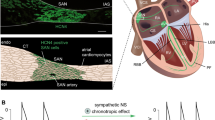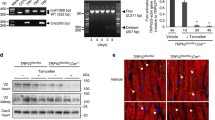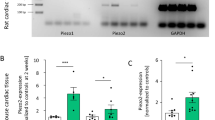Abstract
TASK-1, a member of the recently identified K2P channel family, is mainly expressed in the heart and the nervous system. TASK-1 is regulated by several physiological and pathological conditions and functions as a background potassium channel. However, there are limited data concerning the significance of TASK-1 in cardiac physiology. We studied the functional role of TASK-1 in the heart by cardiac phenotyping the TASK-1-deficient mouse (TASK-1−/−). TASK-1 was predominantly expressed in the ventricles of control animals. Real-time PCR and immunoblot demonstrated that the expression of seven other K2P channels was unchanged in TASK-1−/− mice. No structural or functional abnormalities were found by histology and echocardiography. Electrophysiological studies recording monophasic action potentials (MAPs) showed a significant prolongation of action potential duration in spontaneously beating and atrially paced hearts, respectively. Surface ECGs of TASK-1−/− mice revealed a significant prolongation of the rate corrected QT interval. Telemetric ECG recordings for 24 h, during physical and pharmacological stress testing and after ischemia/reperfusion injury did not result in a higher incidence of arrhythmias. Infarct size was comparable in both genotypes. However, TASK-1−/− mice had a higher mean heart rate and significantly reduced heart rate variability (HRV). Time and frequency domain measurements as well as baroreceptor reflex testing revealed a sympathovagal imbalance with a shift to an increase in sympathetic influence in TASK-1−/− mice. In conclusion, TASK-1 plays a functional role in the repolarization of the cardiac action potential in vivo and contributes to the maintenance of HRV.





Similar content being viewed by others
Abbreviations
- TWIK:
-
Tandem pore domain weak inward rectifying K+ channel
- TASK:
-
TWIK related acid-sensitive K+ channel
- TREK:
-
TWIK related K+ channel
- RRU:
-
Relative RNA unit
- AR:
-
Area at risk
References
Aller MI, Veale EL, Linden A-M, Sandu C, Schwaninger M, Evans LJ, Korpi ER, Mathie A, Wisden W, Brickley SG (2005) Modifying the subunit composition of TASK-1 channels alters the modulation of a leak conductance in cerebellar granule neurons. J Neurosci 25:11455–11467
Backx PH, Marban E (1993) Background potassium current active during the plateau of the action potential in guinea pig ventricular myocytes. Circ Res 72:890–900
Bárándi L, Virág L, Jost N, Horváth Z, Koncz I, Papp R, Harmati G, Horváth B, Szentandrássy N, Bányász T, Magyar J, Zaza A, Varró A, Nánási PP (2010) Reverse rate-dependent changes are determined by baseline action potential duration in mammalian and human ventricular preparations. Basic Res Cardiol 105:315–323
Barbuti A, Ishii S, Shimizu T, Robinson RB, Feinmark SJ (2002) Block of the background K+ channel TASK-1 contributes to arrhythmogenic effects of platelet-activating factor. Am J Physiol Heart Circ Physiol 282:H2024–H2030
Bayliss DA, Sirois JE, Talley EM (2003) The TASK family: two pore-domain background K+ channels. Mol Interv 3:205–219
Bernstein D (2003) Exercise assessment of transgenic models in human cardiovascular disease. Physiol Genomics 13:217–226
Besana A, Barbuti A, Tateyama MA, Symes AJ, Robinson RB, Feinmark SJ (2004) Activation of protein kinase Cε inhibits the two-pore domain K+ channel, TASK-1, inducing repolarization abnormalities in cardiac ventricular myocytes. J Biol Chem 279:33154–33160
Casimiro MC, Knollmann BC, Ebert SN, Vary JC Jr, Greene AE, Franz MR, Grinberg A, Huang SP, Pfeifer K (2001) Targeted disruption of the Kcnq1 gene produces a mouse model of Jervell and Lange–Nielsen syndrome. Proc Natl Acad Sci USA 98:2526–2531
Chandler NJ, Greener ID, Tellez JO, Inada S, Musa H, Molenaar P, DiFrancesco D, Baruscotti M, Longhi R, Anderson RH, Billeter R, Sharma V, Sigg DC, Boyett MR, Dobrzynski H (2009) Molecular architecture of the human sinus node. Insights into the function of the cardiac pacemaker. Circulation 119:1562–1575
Coetzee WA, Amarillo Y, Chiu J, Chow A, Lau D, McCormack T, Moreno H, Nadal MS, Ozaita A, Pountney D, Saganich M, Vaga-Saenz de Miera E, Rudy B (1999) Molecular diversity of K+ channels. Ann N Y Acad Sci 868:233–285
Collins KA, Korcarz CE, Lang RM (2003) Use of echocardiography for the phenotypic assessment of genetically altered mice. Physiol Genomics 13:227–239
Czirjak G, Fischer T, Spät A, Lesage F, Enyedi P (2000) TASK (TWIK-related acid-sensitive K+ channel) is expressed in glomerulosa cells of rat adrenal cortex and inhibited by angiotensin II. Mol Endocrinol 14:863–874
Czirjak G, Petheo GL, Spät A, Enyedi P (2001) Inhibition of TASK-1 potassium channel by phospholipase C. Am J Physiol Cell Physiol 281:C700–C708
Davies LA, Hu C, Guagliardo NA, Sen N, Chen X, Talley EM, Carey RM, Bayliss DA, Barrett PQ (2008) TASK channel deletion in mice causes primary hyperaldosteronism. Proc Natl Acad Sci USA 105:2203–2208
Duprat F, Lesage F, Fink M, Reyes R, Heurteaux C, Lazdunski M (1997) TASK, a human background K+ channel to sense external pH variations near physiological pH. EMBO J 16:5464–5471
Ellinghaus P, Scheubel RJ, Dobrev D, Ravens U, Holtz J, Huetter J, Nielsch U, Morawietz H (2005) Comparing the global mRNA expression profile of human atrial and ventricular myocardium with high-density oligonucleotide arrays. J Thorac Cardiovasc Surg 129:1383–1390
Fabritz L, Kirchhof P, Franz MR, Eckhardt L, Mönnig G, Milberg P, Breithardt G, Haverkamp W (2003) Prolonged action potential durations, increased dispersion of repolarization, and polymorphic ventricular tachycardia in a mouse model of proarrhythmia. Basic Res Cardiol 98:25–32
Gehrmann J, Frantz S, Maguire CT, Vargas M, Ducharme A, Wakimoto H, Lee RT, Berul CI (2001) Electrophysiological characterization of murine myocardial ischemia and infarction. Basic Res Cardiol 96:237–250
Gurney AM, Osipenko AN, MacMillan D, McFarlane KM, Tate RJ, Kempsill FEJ (2003) Two-pore domain K channel, TASK-1, in pulmonary artery smooth muscle cells. Circ Res 93:957–964
Gurney AM, Manoury B (2009) Two-pore potassium channels in the cardiovascular system. Eur Biophys J 38:305–318
Heitzmann D, Derand R, Jungbauer S, Bandulik S, Sterner C, Schweda F, El Wakil A, Lalli E, Guy N, Mengual R, Reichold M, Tegtmeier I, Bendahhou S, Gomez-Sanchez CE, Aller MI, Wisden W, Weber A, Lesage F, Warth R, Barhanin J (2008) Invalidation of TASK-1 potassium channels disrupts adrenal gland zonation and mineralocorticoid homeostasis. EMBO J 27:179–187
Jost N, Acsai K, Horváth B, Bányász T, Baczkó I, Bitay M, Bogáts G, Nánási PP (2009) Contribution of IKr and IK1 to ventricular repolarization in canine and human myocytes: is there any influence of action potential duration? Basic Res Cardiol 104:33–41
Kirchheim HR, Just A, Ehmke H (1998) Physiology and pathophysiology of baroreceptor function and neuro-hormonal abnormalities in heart failure. Basic Res Cardiol 93(Suppl1):1–22
Knollmann BC, Katchmann AN, Franz MR (2001) Monophasic action potential recordings from intact mouse heart: validation, regional heterogeneity, and relation to refractoriness. J Cardiovasc Electrophysiol 12:1286–12941
Ko SH, Lee SK, Han YJ, Choe H, Kwak YG, Chae SW, Cho KP, Song HS (1997) Blockade of myocardial ATP-sensitive potassium channels by ketamine. Anesthesiology 87:68–74
Koizumi H, Smerin SE, Yamanishi T, Moorjani BR, Zhang R, Smith JC (2010) TASK channels contribute to the K+-dominated leak current regulation respiratory rhythm generation in vitro. J Neurosci 12:4273–4284
Kojic ZZ, Flögel U, Schrader J, Decking UKM (2003) Endothelial NO formation does not control myocardial O2 consumption in mouse heart. Am J Physiol Heart Circ Physiol 285:H392–H397
Leonoudakis D, Gray AT, Winegar BD, Kindler CH, Harada M, Taylor DM, Chavez RA, Forsayeth JR, Yost CS (1998) An open rectifier potassium channel with two pore domains in tandem cloned from rat cerebellum. J Neurosci 18:868–877
Lesage F, Lazdunski M (2000) Molecular and functional properties of two-pore-domain potassium channels. Am J Physiol Renal Physiol 279:F793–F801
Maingret F, Patel AJ, Lazdunski M, Honoré E (2001) The endocannabinoid anandamide is a direct and selective blocker of the background K+ channel TASK-1. EMBO J 20:47–54
Meuth SG, Kleinschnitz C, Broicher T, Austinat M, Braeuninger S, Bittner S, Fischer S, Bayliss DA, Budde T, Stoll G, Wiendl H (2009) The neuroprotective impact of the leak potassium channel TASK1 on stroke development in mice. Neurobiol Dis 33:1–11
Mitchell GF, Jeron A, Koren G (1998) Measurement of heart rate and Q–T interval in the conscious mouse. Am J Physiol 274:H747–H751
Mohler PJ, Schott JJ, Gramolini AO, Dilly KW, Guatimosim S, duBell WH, Song LS, Haurogne K, Kyndt F, Ali ME, Rogers TB, Lederer WJ, Escande D, LeMarec H, Bennett V (2003) Ankyrin-B mutation causes type 4 long-QT cardiac arrhythmia and sudden death. Nature 421:634–639
Olschewski A, Li Y, Tang B, Hanze J, Eul B, Bohle RM, Wilhelm J, Morty RE, Brau ME, Weir K, Kwapiszewska G, Klepetko W, Seeger W, Olschewski H (2006) Impact of TASK-1 in human pulmonary artery smooth muscle cells. Circ Res 98:1072–1080
Patel AJ, Honoré E, Lesage F, Fink M, Romey G, Lazdunski M (1999) Inhalational anesthetics activate two-pore-domain background K+ channels. Nat Neurosci 2:422–426
Petzelbauer P, Zacharowski PA, Miyazaki Y, Friedl P, Wickenhauser G, Castellino FJ, Gröger M, Wolff K, Zacharowski K (2005) The fibrin-derived peptide Bβ15-42 protects the myocardium against ischemia-reperfusion injury. Nat Med 11:298–304
Putzke C, Wemhöner K, Sachse FB, Rinne S, Schlichthörl G, Li XT, Jae L, Eckhardt I, Wischmeyer E, Wulf H, Preisig-Müller R, Daut J, Decher N (2007) The acid-sensitive potassium channel TASK-1 in rat cardiac muscle. Cardiovasc Res 75:59–68
Roden DM, Balser JR, George AL, Anderson ME (2002) Cardiac ion channels. Annu Rev Physiol 64:431–475
Roth DM, Swaney JS, Dalton ND, Gilpin EA, Ross J (2002) Impact of anesthesia on cardiac function during echocardiography in mice. Am J Physiol Heart Circ Physiol 282:H2134–H2140
Sirois JE, Lei Q, Talley EM, Lynch C III, Bayliss DA (2000) The TASK-1 two-pore domain K+ channel is a molecular substrate for neuronal effects of inhalational anesthetics. J Neurosci 20:6347–6354
Talley EM, Bayliss DA (2002) Modulation of TASK-1 (KCNK3) and TASK-3 (KCNK9) potassium channels. J Biol Chem 277:17733–17742
Tanaka N, Dalton N, Mao L, Rockman HA, Peterson KL, Gottshall KR, Hunter JJ, Chien KR, Ross J Jr (1996) Transthoracic echocardiography in models of cardiac disease in the mouse. Circulation 94:1109–1117
Tang B, Li Y, Nagaraj C, Morty RE, Gabor S, Stacher E, Voswinckel R, Weissmann N, Leithner K, Olschewski H, Olschewski A (2009) Endothelin-1 inhibits background two-pore domain channel TASK-1 in primary human pulmonary artery smooth muscle cells. Am J Resp Cell Mol Biol 41:476–483
TASK Force of the European Society of Cardiology and the North American Society of Pacing and Electrophysiology (1996) Heart rate variability. Eur Heart J 17:354–381
Thireau J, Zhang BL, Poisson D, Babuty D (2007) Heart rate variability in mice: a theoretical and practical guide. Exp Physiol 93:83–94
Trapp S, Aller IM, Wisden W, Gourine AV (2008) A role of TASK-1 (KCNK3) channels in the chemosensory control of breathing. J Neurosci 35:8844–8850
Waldeyer C, Fabritz L, Fortmüller L, Gerss J, Damke D, Blana A, Laakmann S, Kreienkamp N, Volkery D, Breithardt G, Kirchhof P (2009) Regional, age-dependent, and genotype-dependent differences in ventricular action potential duration and activation time in 410 Langendorff-perfused hearts. Basic Res Cardiol 104:523–533
Washburn CP, Bayliss DA, Guyenet PG (2003) Cardiorespiratory neurons of the rat ventrolateral medulla contain TASK-1 and TASK-3 channel mRNA. Respir Physiol Neurobiol 138:19–35
Weiergräber M, Henry M, Südkamp M, de Vivie E-R, Hescheler J, Schneider T (2005) Ablation of Cav2.3/E-type voltage-gated calcium channel results in cardiac arrhythmia and altered autonomic control within the murine cardiovascular system. Basic Res Cardiol 100:1–13
Wickman K, Nemec J, Gendler SJ, Clapham DE (1998) Abnormal heart rate regulation in GIRK4 knockout mice. Neuron 20:103–114
Yamamoto Y, Kummer W, Atoji Y, Suzuki Y (2002) TASK-1, TASK-2, TASK-3 and TRAAK immunoreactivities in the rat carotid body. Brain Res 950:304–307
Acknowledgments
The TASK-1−/− mouse was supplied by Dr. W. Wisden from the Department of Clinical Neurobiology, University of Heidelberg. Dr. Sager and Dr. Engelhardt, Animal Care Facility Duesseldorf, are acknowledged for their encouraging help with the animal experiments. The work was supported by two grants from the University Duesseldorf and by the German Society for Pediatric Cardiology. MS was a recipient of “Forschungsförderung der Universität Düsseldorf”.
Conflict of interest
The authors declare that they have no conflict of interest.
Author information
Authors and Affiliations
Corresponding author
Electronic supplementary material
Below is the link to the electronic supplementary material.
Rights and permissions
About this article
Cite this article
Donner, B.C., Schullenberg, M., Geduldig, N. et al. Functional role of TASK-1 in the heart: studies in TASK-1-deficient mice show prolonged cardiac repolarization and reduced heart rate variability. Basic Res Cardiol 106, 75–87 (2011). https://doi.org/10.1007/s00395-010-0128-x
Received:
Revised:
Accepted:
Published:
Issue Date:
DOI: https://doi.org/10.1007/s00395-010-0128-x




